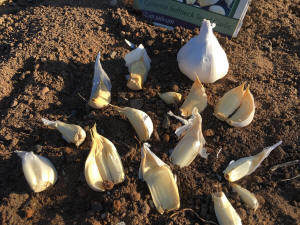|
 Plant
Flavorful and Nutritious Garlic in Fall Plant
Flavorful and Nutritious Garlic in Fall
By Melinda Myers
[October 04, 2025]
Lower your
blood pressure and cholesterol, fight heart disease, boost your
immune system, and add a bit of flavor to your meals by growing your
own garlic. This vegetable has been used as both food and medicine
for thousands of years.
Purchase firm, healthy bulbs of garlic sold for growing in the
garden. One pound of garlic typically fills a 30’ row but this can
vary depending on the variety. It’s best not to use garlic sold at
the grocery store as it may have been treated to prevent sprouting
and it may not be suitable for growing in your climate. |
Select the best variety for your growing conditions and preferred
flavor. Hardneck garlic typically prefers colder climates while most
softneck garlic prefers warmer climates, but this varies with the
varieties within each group. Hardneck garlic varieties develop a
stiff flower stalk, tend to have larger cloves, and flavors ranging
from mild to spicy. Softneck varieties vary in their adaptability to
long cold winters, cool moist springs and warm summers. They lack
the stiff flower stalk so the leaves can be braided, and the bulbs
tend to have a longer shelf life.
Garlic bulbs typically contain seven or more individual cloves. The
larger the clove you plant, the bigger the bulb you’ll harvest.
Separate the cloves right before planting and do not remove the
papery covering. Use the largest cloves for growing and the smaller
ones to flavor your favorite fall and winter meals.
Grow garlic in a sunny location with well-drained soil. Prepare the
soil by adding organic matter like compost and a low nitrogen
slow-release fertilizer. Avoid high nitrogen, fast release
fertilizers that promote top growth with smaller bulbs. Fertilize
again in spring as growth begins.
Plant the cloves in the fall about six weeks before the ground
freezes in cold climates and late fall or early winter in warmer
regions. Space individual cloves six inches apart with the pointed
side up and the base of the clove two to three inches below the soil
surface. Space single rows 12 to 14 inches apart or double rows six
inches apart with 30” between each set of double rows. For more
intensive wide row and square foot growing, plant multiple rows with
four to eight inches between cloves.
Spread a six-inch layer of weed-free straw over the soil surface
after planting to conserve moisture and suppress weeds. This also
provides added insulation in colder regions and helps prevent frost
heaving that occurs when temperatures fluctuate, causing soil to
alternately freeze, thaw and shift throughout the winter. Cover the
straw with evergreen boughs in windy locations to help hold the
straw in place.
[to top of second column] |

Water newly planted garlic thoroughly at planting and as needed in
fall to encourage the roots and a shoot to form. Water often enough
to keep the soil evenly moist during the growing season.
Inconsistent moisture when the plants are actively growing results
in smaller and misshapen bulbs. Keep the soil around the plants
covered with organic mulch to conserve moisture and suppress weeds.
Make this the season you plant garlic. Then enjoy the homegrown
flavor and health benefits it provides.
Melinda Myers has written more than 20 gardening books,
including the Midwest Gardener’s Handbook, 2nd Edition and Small
Space Gardening. She hosts The Great Courses “How to Grow Anything”
instant video and DVD series and the nationally syndicated Melinda’s
Garden Moment TV & radio program. Myers is a columnist and
contributing editor for Birds & Blooms magazine and was commissioned
by Summit for her expertise to write this article. Myers’ website is www.MelindaMyers.com.
[Photo courtesy of MelindaMyers.com]
 |